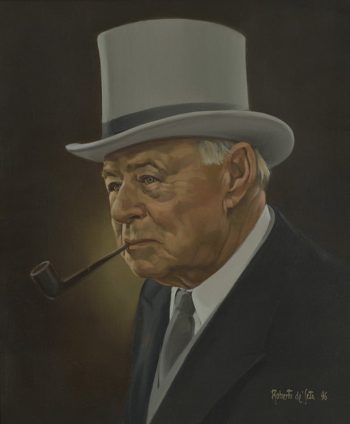Edward Plunket Taylor
- Canadian Agricultural Hall of Fame
- Inductees
- Edward Plunket Taylor

- Inducted: 1996
- Residing Province: Ontario
- Gallery Location: 163
Edward Plunket Taylor
- (1901
- -
- 1989)
Edward Plunket Taylor, one of Canada’s leading industrialists purchased his first Thoroughbred race horse for $800 in 1936. From that modest beginning, he developed his Windfields Farm into one of the world’s most influential breeding establishments.
From his first farm, on Bayview Avenue north of Toronto, Mr. Taylor expanded to Oshawa, when he acquired Col. R.S. McLaughlin’s Parkwood stud in 1950. In the 1960s and 1970s he developed yet another major breeding farm in Maryland.
As the leading force in the Ontario Jockey Club after the Second World War, Mr. Taylor reorganized the archaic system of racing in the province, and most notably opened the new Woodbine race track in 1956. He was the first Canadian member of The Jockey Club (USA) and later became the first Chief Steward of The Jockey Club of Canada. He is a member of The Canadian Racing Hall of Fame and the Canadian Sports Hall of Fame.
His most famous race horse was the legendary Northern Dancer who was the first Canadian-bred winner of the Kentucky Derby, in 1964, and then became the world’s leading Thoroughbred stallion. Taylor and Windfields have also bred 21 Queen’s Plate winners, three English Derby winners and a record 350 stakes winners.
In the early-1950s, after hiring an experienced herdsman from Scotland, Mr. Taylor began to develop an outstanding Aberdeen Angus herd. He also engaged a young Canadian, Jim Mowbray, who was to take over the herd and spark its great success.
During the late-1950s, Windfields Farm won numerous Angus championships at the Royal Agricultural Winter Fair. The farm dominated the Premier Breeder and other championship classes for 12 years after 1960 on the western Canada show circuit. At the Canadian National Exhibition, Windfields was selected as Premier Breeder every year from 1963 to 1972. The herd was dispersed in 1973 because of encroaching land development in the Bayview area.
During the Second World War, Mr. Taylor was a dollar-a-year man for the Canadian government. Working in Washington and London, as well as Canada, and surviving the sinking of his ship by a German submarine, he was a leader in the production and supply of billions of dollars worth of Canadian arms and munitions to the armed forces of all three nations. After the war, King George VI made Mr. Taylor a Companion of the Order of St. Michael and St. George in recognition of his services.
Edward Plunket Taylor, l’un des grands industriels du Canada, a acheté son premier cheval de course pur-sang pour
800 $ en 1936. De ces modestes débuts, il a développé sa ferme Windfields pour devenir un des établissements
d’élevage les plus influents du monde.
De sa première ferme, sur l’avenue Bayview au nord de Toronto, M. Taylor s’est déplacé à Oshawa, où il a acquis en
1950 le haras du Col. RS Parkwood McLaughlin. Dans les années 1960 et 1970, il a développé une autre grande
ferme d’élevage dans le Maryland.
Un acteur majeur dans l’Ontario Jockey Club après la Seconde Guerre mondiale, M. Taylor a réorganisé le système
archaïque de la course de chevaux dans la province, et a notamment inauguré la nouvelle piste de course Woodbine
en 1956. Il a été le premier membre canadien du Jockey Club (USA) et est devenu plus tard le premier Intendant en
chef du Jockey Club du Canada. Il est membre du Canadian Racing Hall of Fame et du Canadian Sports Hall of
Fame.
Son plus célèbre cheval de course était la légendaire Northern Dancer qui était le premier cheval d’élevage canadien
vainqueur du Derby du Kentucky, en 1964, puis est devenu le premier étalon Thouroughbred du monde. Taylor et
Windfields ont également élevé 21 gagnants du Queen’s Plate, trois gagnants du English Derby et un nombre record
de 350 vainqueurs de courses.
Au début des années 1950, après l’embauche d’un gérant de troupeau écossais expérimenté, M. Taylor a commencé
à développer un remarquable troupeau Aberdeen Angus. Il a également embauché un jeune Canadien, Jim
Mowbray, qui a repris le troupeau et en a fait un grand succès.
À la fin des années 1950, la ferme Windfields a remporté de nombreux championnats Angus au Royal Agricultural
Winter Fair. La ferme a dominé les prix de Premier Éleveur et d’autres classes de championnat pendant 12 ans à
partir de 1960 sur le circuit de l’Ouest du Canada. Au Canadian National Exhibition, Windfields a été choisi comme
Premier Éleveur chaque année de 1963 à 1972. Le troupeau a été dispersé en 1973 en raison de l’empiètement
urbain sur les terres dans la région de Bayview.
Pendant la Seconde Guerre mondiale, M. Taylor était un ‘homme d’un dollar par année’ à travailler pour le
gouvernement canadien. Travaillant à Washington et à Londres, ainsi qu’au Canada, et survivant du naufrage de son
navire par un sous-marin allemand, il a été un leader dans la production et l’approvisionnement de plusieurs milliards
de dollars d’armes et de munitions canadiennes aux forces armées des trois pays. Après la guerre, le roi George VI
lui a remis la distinction de Compagnon de l’Ordre de Saint-Michel et Saint-Georges en reconnaissance de ses
services.
- The Royal Agricultural Winter Fair
- Lt. Col. Charles Baker
- The Canadian Thoroughbred Society
- The Ontario Jockey Club
- The Jockey Club of Canada


